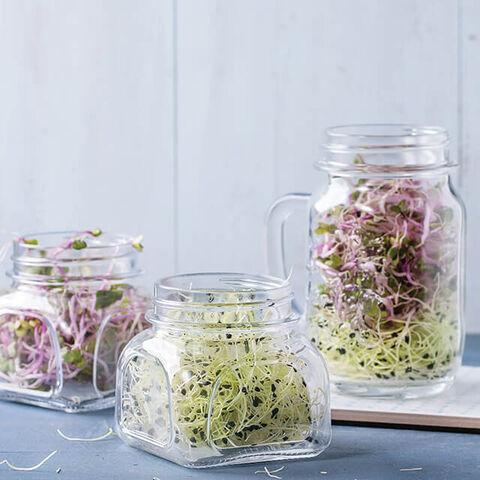Turn your kitchen into a living room by growing your own sprouts
What you need:
Seeds for sprouting (try sproutpeople.org, where a pound can run $6 to $30, depending on the type, or get smaller amounts at a natural foods store or co-op)
Clean and sterilized wide-mouth mason jars
and lids or rubber bands
A shallow cake pan or Pyrex dish
Cheesecloth or dishcloth (cut to size)
For alfalfa and smaller sprouts:
Pour about a teaspoon of seeds into your mason jar. Fill the jar halfway with water and swirl to separate and coat every seed. Cover the jar with the cloth and secure with a rubber band or jar ring. Pour out excess water, tap to disperse seeds throughout the jar, then fill with more water to cover the seeds. Soak for a couple hours then drain. Rinse the seeds every day by adding water to the jar, swirling, then pouring out the excess and shaking the seeds into position. Place the jar somewhere it will get consistent indirect light, like near a kitchen window. After about a week, you can start to pull out sprouts. Store in the fridge if you don’t just eat them in one big mound like a brachiosaurus.
For mung beans and larger sprouts:
Put a teaspoon or so of seeds in a cake pan, or any shallow tray or dish, rinse thoroughly, and pick out any that are broken or floating. Soak for a couple hours then pour out excess water. Cover with something clear (cling wrap works great). Set near a window. Every day, rinse the seeds in this same way, making sure they don’t dry out between rinsings. After a few days, they’ll start to soften and open. In about a week, you’ll have bean sprouts for all your snacking needs.
Throw some sprouts on a salad or sandwich and it’s like a tasty bonus round of nutrients. Growing your own at home is so easy it kind of feels like magic. Plus, it’s a lot less expensive than buying them and offers more options, too. Not that into bean sprouts? Try peas or lentils. Sick of alfalfa? Go for broccoli or beets. Just be sure to get seeds specifically for sprouting; seeds for planting can have extra ingredients that aren’t safe to eat.
For both methods of sprouting, watch for signs of pathogens (fuzziness or discoloration) and discard anything older than 10 days before re-sterilizing your supplies and starting again. –jenny rose ryan
PHOTOS: shutterstock (sprouts)
This article originally appeared in the Fall 2021 print edition of BUST Magazine. Subscribe today!


